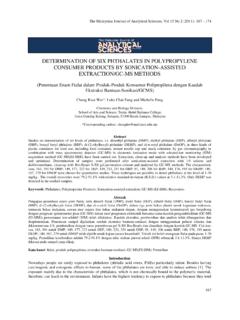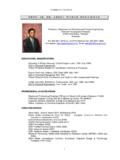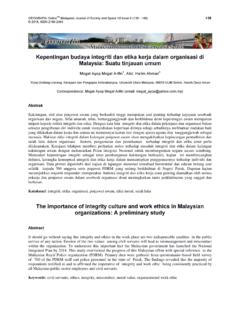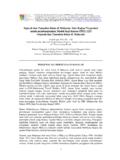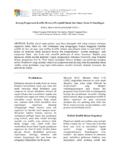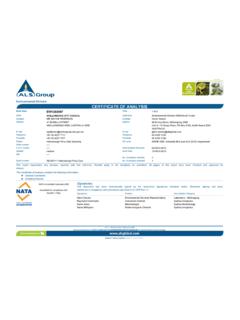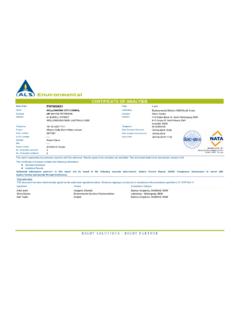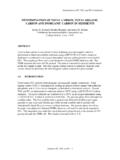Transcription of EFFECTS OF INDUCED SALINITY ON BOD REACTION …
1 The Malaysian Journal of Analytical Sciences, Vol 14 No 1 (2010): 24 - 31 24 EFFECTS OF INDUCED SALINITY ON BOD5 REACTION KINETICS OF RIVER water samples (Kesan Peningkatan Kemasinan Terhadap Kinetik Tindak Balas keperluan oksigen biokimia 5 Hari Menggunakan Sampel Air Sungai) Zaki Zainudin1*, Maketab Mohamed2, Mohd. Rosslim Ramli3 1 water Resources Technical Division, Institution of Engineers Malaysia, 46720 Petaling Jaya, Selangor Darul Ehsan 2 Faculty of Chemical and Natural Resources Engineering, Universiti Teknologi Malaysia, 81310 Skudai, Johor, Malaysia 3 Faculty of Chemical Engineering, Universiti Teknologi MARA, 40450 Shah Alam, Selangor, Malaysia *Corresponding author: Abstract Biochemical Oxygen Demand (BOD) is a typical parameter used in assessing organic pollution strength in surface waters and is normally tested over a 5-day period at an incubation temperature of 20 C (BOD5).
2 The accuracy of this constituent, in assessing organic contamination under brackish conditions has always been known to be somewhat limited as elevated concentrations of chloride (Cl-) disrupts microbial activity from osmotic cellular degradation, causing the bottle decay rate, k1, to be effected. The aim of this study was to quantify the EFFECTS of INDUCED SALINITY on k1, with varying levels of sodium chloride (NaCl) concentration (5 25 ppt), towards six mildly polluted to polluted tropical river water samples . The observed variations ranged between of k1 for the stipulated samples using the Thomas graphical method for determination of the k1 rate constant.
3 Sg. Rawang depicted the highest quantum of difference in k1, with decrement from (0 ppt) to (25 ppt), whereas Sg. Klang showed the lowest quantum, from (0 ppt) to (25 ppt). Keywords : BOD5 saline, brackish, estuarine, bottle decay rate Abstrak keperluan oksigen biokimia (BOD) adalah metodologi biasa yang digunakan untuk menilai kekuatan pencemaran bahan organik dalam air dan biasanya diuji dalam jangka masa 5 hari pada suhu inkubasi 20 C (BOD5). Ketepatan BOD5, untuk menilai kontaminasi organik dalam air masin sememangnya diketahui agak terhad akibat daripada kandungan klorida (Cl-) tinggi yang mengganggu aktiviti mikrob, di mana berlakunya pelupusan sel dari proses osmosis, yang seterusnya menyebabkan gangguan terhadap kadar pereputan dalam botol (k1).
4 Tujuan kajian ini adalah untuk menghisab kesan kemasinan terhadap k1, dengan meningkatkan kepekatan Natrium Klorida (NaCl) secara berperingkat, antara 5 25 bpj, terhadap enam sampel air sungai yang diklasifikasikan sebagai sedikit tercemar hingga tercemar. Didapati variasi k1 umumnya berada antara menggunakan metodologi pengukuran grafikal Thomas. Sg. Rawang menunjukkan perbezaan ketara dalam nilai k1, dengan kejatuhan daripada (0 bpj) ke (25 bpj), manakala Sg. Klang pula menunjukkan perbezaan paling minima dari (0 bpj) ke (25 bpj). Katakunci : BOD5 air masin, pencemaran organik di kawasan kuala sungai, kadar pereputan dalam botol Introduction Biochemical Oxygen Demand (BOD) is a fundamental parameter used in the assessment of organic contaminants present in water and wastewater.
5 The parameter was first used in the early 1900s as an indicator of organic contamination from sewage sources in the United Kingdom (UK). An incubation time of 5 days at 20 C for testing, brought about the acronym BOD5, with the primary justification that the maximum retention time of organic pollutants from sewerage sources of rivers in the UK was in accordance to these conditions [1]. The test itself in-turn, is primarily governed by three things; (1) the amount of biodegradable organic matter present, (2) mix culture of microbial population that propagates the degradation and (3) acceptable dissolved oxygen levels for microbial aerobic respiration.
6 The amount of biodegradable organic matter present (left hand side of the Eq. ), is the primary constituent of concern measured in the test, as excess amounts of organic matter may contribute towards in-stream oxygen depletion, commonly referred to as the DO sag [2] ; Zaki Zainudin et al: EFFECTS OF INDUCED SALINITY ON BOD5 REACTION KINETICS OF RIVER water samples 25 NewCellscNHOHc232anCOc)O432b4a(nNOHC3222 cban++ + ++ (1) A universal qualifier used in BOD testing is that, only the carbonaceous fraction (or cBOD), is measured as this portion truly reflects the biodegradable organics present.
7 The resulting ammonia, NH3-N, which is a product of the degradation, exhibits its own oxygen demand after a few days, during the transformation of NH3-N to NO2-N and NO3-N (nitrification). This oxygen demand is referred to as nitrogenous BOD or nBOD. In order to inhibit the EFFECTS of nBOD, nitrification inhibitors such as TCMP (2-chloro-6-(trichloro-methyl) pyridine) is utilized [3]. Throughout the degradation process, there must be sufficient levels of dissolved oxygen (DO) in the BOD test bottle, preferably above 2 mg/l. Depletion of DO below this value at any time during the test, will incur anoxic conditions, causing stress to the microbial population, hence affecting the BOD readings.
8 If the value falls below 2 mg/l on the fifth day, the sample will simply be rejected and not considered to be part of the result. This is why many analytical references on BOD testing often recommend preparation of serial dilutions of the same sample, where incubation is done simultaneously [1]. The final variable for consideration is the quantity and type of microorganisms present. The microorganisms, which drive the degradation process can either be introduced through seeding or assumed to be already present in ambient water sample. As an added precautionary measure, seeding is often recommended by analytical references [3]. Though being the case, the quantification of the microbial population in the BOD tests remains arbitrary in many practices.
9 This does not mean that this variable is unimportant; after all it is the microorganisms that incur DO depletion in the test bottle. Any disturbance, whether it is natural or otherwise, to microbial growth, will disrupt the first-order REACTION kinetics and hence affect the BOD results [4]. Problem Statement The presence of reagents such as chlorine (Cl2), widely used as a disinfectant, in water and wastewater treatment plants in many developing countries, is a good example of the disturbances discussed above. Chlorine is effective in removing coliform organisms such as Escherichia coli (E. coli) and Enterococcus spp., by incurring osmotic cellular protoplasmic decomposition [5].
10 The EFFECTS of these types of disinfectants on microbes are widely recognized, though little is known on the implications towards the BOD test itself, when samples due for testing contain elevated levels of the constituent. A chlorine check is typically recommended prior to commencement of BOD5 analysis [3]. Another perspective is, to look at this in terms of application of the BOD test for assessment of ambient water quality, particularly at the estuarine zone where SALINITY levels, as a result of chloride (NaCl) is predominant. It has been long accepted that BOD, as a parameter of assessment for organic contamination under such conditions is not preferable, where Total Organic Carbon (TOC) analysis is more preferred [6].
